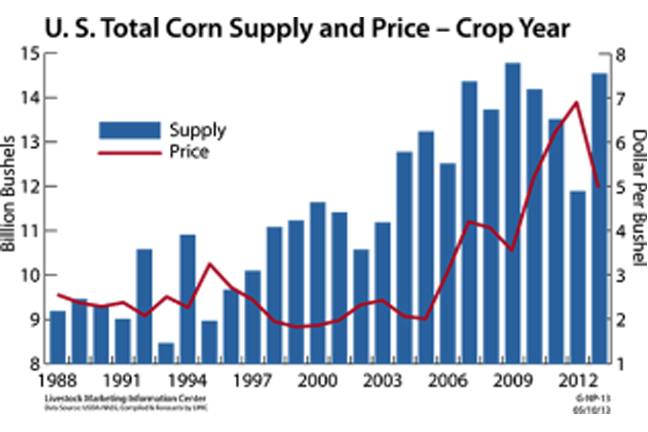
Agricultural News
Supply and Demand Influence Corn Prices
Mon, 01 Jul 2013 17:06:20 CDT

In a free market economy, price is ultimately determined by the supply and demand for a product or commodity. Short-term price gyrations often occur and can be influenced by market reactions to news concerning such things as weather, government reports and/or policy. Corn is a commodity that reflects this scenario
Profitability in the cattle industry is heavily influenced by the price of corn. Corn, fed whole or further processed, is used as an energy supplement in growing rations and as a main ingredient in the diet of cattle being finished for slaughter. In addition, the byproducts produced from corn processed for food and fuel, such as corn germ, hominy feed, corn gluten feed and distillers grain, are used extensively in cattle rations. Having an understanding of corn market dynamics can be useful in helping cattle owners manage the price of feed, one of the major costs of production.
The price of corn is largely determined by supply and demand. On the supply side, there are basically three sources of U.S. corn. The first source comes from leftover stocks from the previous year. This usually provides between 1 and 2 billion bushels, although the 2013 number will likely be roughly 750 million bushels due to the reduced 2012 crop.
The second and largest contributor to supply is current domestic production. In the last 10 years, the nation's corn crop has varied from 10 to 14 billion bushels. Weather plays an important role in crop production. This is especially true in regard to planting and harvest dates, both of which impact the total size of the crop. The United States Department of Agriculture (USDA) publishes several crop reports each year: a late March report on acres expected to be planted; weekly crop progress reports from April through November; and estimated ending stock reports in January, March, June and September. These reports often cause wide price swings as the market interprets the numbers.
The third source comes from international imports - typically only a few million bushels. However, imports will be higher than average in 2013 because of high U.S. corn prices. Current estimates for 2013 are near 150 million bushels. All these sources added together have provided the U.S. corn market with an average of 13 to 14 billion bushels during the last 10 years.
There are also three major sources of demand for corn. The first category is feed and residual. On average during the last 10 years, roughly 4.5 to 5 billion bushels, or 35 percent of the corn, is used for feed. There has been a significant decline in the amount of corn used for feed during the last five years.
The second source of demand is exports. The U.S. is a major supplier of corn to many countries, including Japan. Over the last decade, the U.S. has, on average, exported just short of 2 billion bushels each year. This accounts for less than 15 percent of the total supply.
The final category, at roughly 40 percent of the supply, is food and industrial use. The largest component in this category is ethanol production. Year-end stocks can also be considered part of demand since the market prefers to have some cushion going into the next crop.
Supply and demand interact to determine price. The market does react to short-term events, but knowing the sources of supply and demand, and when estimates of these are released, will provide the opportunity to purchase corn and cattle feed at lower prices.
By Dan Childs, Senior Consultant - Agricultural Economist, Samuel Roberts Noble Foundation
WebReadyTM Powered by WireReady® NSI
Top Agricultural News
More Headlines...




















